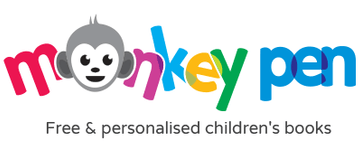The Reading-Coloring Connection: How Art Activities Boost Literacy Skills
Oct 30, 2025
Coloring with crayons brings to mind colorful pages and kids having fun. But coloring is much more than an activity for entertainment: it plays a vital part in children's learning how to write, read, and tell stories. The link between coloring and literacy may be a surprise, but it plays an important role in helping children build strong foundations for learning. In MonkeyPen, where books for children and their creativity are carefully linked, the connection feels particularly important.
Here we'll look at the ways that coloring can help with pre-reading and enhance visual learning among children, and also help develop storytelling skills that improve the capacity to read throughout life.
How Colouring Builds Pre-Reading Skills
Before children can even open their very first novel, they have to acquire pre-reading skills. These are the little steps that help young readers to recognize letters, read words, and, eventually, be able to read sentences. Coloring is one of the easiest ways to help develop these abilities in the early years.
When a child draws those lines in a drawing, it helps them develop hand-eye coordination. The same skill helps later on when holding the pencil to create letters. Every stroke made with a pencil increases their fine motor abilities and prepares your hands to handle the more exact job of writing.
Coloring also helps children be aware of lines, shapes, and patterns. Recognizing the curves in circles or the elongated edge of a square can lay the foundation for recognition of letters. For instance, an infant who quickly detects a circular shape will be able to recognize letters like 'o and 'c'. This is why coloring can be one of the best ways to prepare youngsters for a world full of words written as they enjoy themselves.
The Power of Visual Learning in Children
Children are naturally visual learners. They understand the world through observation and comparing the things they perceive. Coloring is a key component of this process of learning, assisting students in sorting information visually and in a hands-on manner.
When kids colour an apple red or sky blue, they're connecting colours to real-world objects. This simple gesture enhances their memory and helps strengthen connections between words. Then, when they read a book that talks about "a red apple," their brains will recall both the color and shape of the apple, making comprehension quicker and more relevant.
Coloring also aids children in practicing visual sequencing, which is the process of putting things in order. For instance, coloring the sequence of events in a photograph (first the sun, followed by the tree, and finally the house) helps develop the same type of thinking required to understand the sequence of stories. This is the reason visual learning by children through arts and crafts can be a powerful tool to develop reading skills.
Furthermore, coloring develops attention and concentration. The act of sitting down and coloring with crayons develops patience and helps children accomplish tasks. These skills translate directly into the ability to read an author's book, follow the story, and be able to comprehend what's being read.
Storytelling Through Art
The most fascinating way that colouring can connect to the concept of literacy is by telling stories. Every picture has a story to be told. When children color and start to think about what might be happening in the picture.
A coloring page with a castle or a dragon could spark many stories. The child might envision a brave knight saving the day or a princess who makes friends with a dragon. As they tell the story of their illustration, they practice with new vocabulary, making sentences, and communicating ideas. This is art storytelling at the moment.
Teachers and parents can help to encourage this talent by asking questions:
- "Who lives in the house you coloured?"
- "What is the puppy doing in your picture?"
- "Where is the girl going with her balloon?"
These little conversations transform simple coloring into a more creative literacy activity. Children do not just learn to color, but they also practice writing narratives, using their imagination, and expanding their vocabulary. All of these are essential to reading and writing achievement.
Bringing Reading and Colouring Together
Coloring and reading are both effective; however, when they are combined, they can enhance learning. Combining reading and coloring activities provides children with the chance to connect words and images in a meaningful manner.
Coloring pictures of the alphabet is the easiest step in learning the alphabet. Kids grasp these letters fast while coloring them.
At MonkeyPen, we have printable alphabet coloring pages and many stories designed to stimulate both reading and creating art. When children color characters or depictions from the stories they enjoy and learn about, their understanding grows. They perceive reading not just as an academic endeavor, but as a part of the larger, fun experience that involves creativity, art, and imagination. You can download our free children's storybooks to keep your munchkins busy with reading or listening.
Why This Connection Matters
The connection between colouring and literacy extends beyond the basics of school readiness. It provides children with confidence in learning, instead of being pressured to read at a young age and then acquiring the knowledge naturally through games they like.
Teachers and parents who recognize the importance of coloring find that children.
- More attentive readers because their concentration and patience have increased.
- More effective storytellers are trained to share concepts through the medium of art.
- More confident learners, as they link visual memory to written words.
Through providing both coloring and reading activities, adults can help develop the full potential of children while making learning fun and enjoyable.
Conclusion
The coloring literacy connection demonstrates to us that each stroke of a crayon is more than play; it is an opportunity to develop confidence in communicating and reading. Through blending coloring with stories and books, teachers and parents give their children the opportunity to enjoy learning.
We at MonkeyPen believe that each child should experience the joy of art and words. Visit our online library of free children's books, educational posters to enhance your kids' basic literacy skills. Reading and coloring can open the doors to imagination, creativity, and a love for learning.
The educational coloring benefits for children that we see today in homeschooling and classroom learning are deeply tied to how coloring boosts neural development, fosters creativity, and helps kids build long-term success. Science shows that coloring engages multiple areas of the brain at once, enhancing focus, fine motor coordination, and even early problem-solving skills. That's why resources like our printable coloring pages for kids are more than just activities—they are powerful aids in supporting growth, learning, and imagination.


